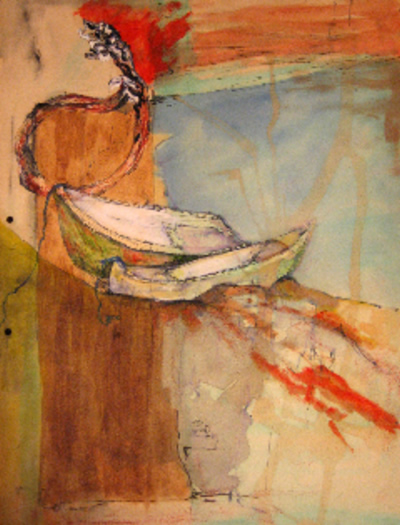Jennie Guy

Brain Patterns
A review of Áine Ivers paintings, for Galleria BE’19 in Helsinki, Finland, November 2007.
* * *
Áine Ivers presents a series of nine drawings as part of this exhibition. The series is called Brain Patterns and approaches the concept of what happens when we endlessly think and re-think. The drawings are executed on heavy paper discovered by the artist. Textile-dye, ink, oil and charcoal are used minimally to form a concentrated atmospheric representation of what happens when you attempt to suspend thoughts that are relentless.
By agreeing to sit for herself Áine Ivers penetrates her own thought patterns by making them visual. In this instance the sitter is complicit with the portrait artist to be unmasked, naked and drawn in moments of self-reflection. In several of the series a figure, bearing only an edgy familiarity to the artist stares out at us. Just as we all can be caught in thought, the artist herself seems not quite there even in her own paintings. The landscapes likewise have an illusory quality. The figures and landscapes are as elusive as the thoughts the artist is attempting to capture. How else could seaweed from the western coast of Ireland be included in a lake -scape depicting the eastern border of Finland except but in the mind. By giving a physical texture to thoughts an anomaly emerges…how can you draw a thought? Yet it is in the attempt to render thought that our unconscious can emerge in its magnitude. By breaking the cycle of contemplation, a multi-layered, delicate and indistinct series of drawings are set down repeatedly as intrigue. The paper yields itself to be drawn upon, painted, shaded and becomes the bearer of the internal being.
Drawing is constructed from lines. By deliberately working amongst and with these lines Áine Ivers allows private and pensive intensities of her own to be exposed. Her thoughts are passing and could be thought of as troubled and weak but it is this process of thinking them and then welcoming them onto paper and giving them a visual language that is a risky acknowledgement of the fact that they have an importance, even in our day to day existence. These thoughts will inevitably come back again, either exactly the same or with a little tweak here or there but because they have been given an alternate language perhaps they can be understood and processed in a more merciful setting.
